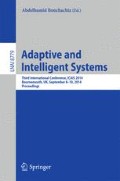Abstract
This paper shows how a planning as inference framework with discrete latent states can be used to implement homeostatic control by providing an agent with multivariate autonomic set points as goals. Before receiving these goals the agent navigates according to the ‘Prior Dynamics’ which embody a cognitive map of the environment. Given the goals, optimal value functions are implicitly computed using a forward and backward message passing algorithm, which is then used to construct the ‘Posterior Dynamics’. We propose that this formalism provides a useful description of computations in the mammalian Hippocampus.
Access this chapter
Tax calculation will be finalised at checkout
Purchases are for personal use only
Preview
Unable to display preview. Download preview PDF.
References
Attias, H.: Planning by probabilistic inference. In: Bishop, C., Frey, B. (eds.) Proceedings of the 9th International Conference on Artificial Intelligence and Statistics (2003)
Bishop, C.M.: Pattern Recognition and Machine Learning. Springer, New York (2006)
Cannon, W.: Organization for Physiological Homeostasis. Physiol Rev. 9, 399–431 (1929)
Daw, N., Niv, Y., Dayan, P.: Uncertainty-based competition between prefrontal and dorsolateral striatal systems for behavioral control. Nat. Neurosci. 8(12), 1704–1711 (2005)
Foster, D., Wilson, M.: Hippocampal theta sequences. Hippocampus 17(11), 1093–1099 (2007)
Friston, K., Kilner, J., Harrison, L.: A free energy principle for the brain. J. Physiol. Paris 100(1-3), 70–87 (2006)
Hassabis, D., Maguire, E.: The construction system of the brain. Philosophical Transactions of the Royal Society London B 364, 1263–1271 (2009)
Johnson, A., Redish, A.: Hippocampal replay contributes to within session learning in a temporal difference reinforcement learning model. Neural Netw. 18(9), 1163–1171 (2005)
Keramati, M., Gutkin, B.: A reinforcement learning theory for homeostatic regulation. In: Neural Information Processing Systems (2011)
Muller, R., Stead, M.: Hippocampal place cells connected by Hebbian synapses can solve spatial problems. Hippocampus 6, 709–719 (1997)
O’Keefe, J., Nadel, L.: The Hippocampus as a Cognitive Map. Oxford University Press (1978)
Penny, W.: Simultaneous localisation and mapping. In: 4th International Workshop on Cognitive Information Processing, Copenhagen, Denmark (2014)
Penny, W., Zeidman, P., Burgess, N.: Forward and Backward Inference in Spatial Cognition. PLoS CB 9(12), e1003383 (2013)
Pfeiffer, B., Foster, D.: Hippocampal place-cell sequences depict future paths to remembered goals. Nature 497, 74–79 (2013)
Sterling, P.: Allostasis: a model of predictive regulation. Physiology and Behaviour 106, 5–15 (2012)
Todorov, E.: Efficient computation of optimal actions. Proceedings National Academy of Sciences 106(28), 11478–11483 (2009)
Author information
Authors and Affiliations
Editor information
Editors and Affiliations
Rights and permissions
Copyright information
© 2014 Springer International Publishing Switzerland
About this paper
Cite this paper
Penny, W., Stephan, K. (2014). A Dynamic Bayesian Model of Homeostatic Control. In: Bouchachia, A. (eds) Adaptive and Intelligent Systems. ICAIS 2014. Lecture Notes in Computer Science(), vol 8779. Springer, Cham. https://doi.org/10.1007/978-3-319-11298-5_7
Download citation
DOI: https://doi.org/10.1007/978-3-319-11298-5_7
Publisher Name: Springer, Cham
Print ISBN: 978-3-319-11297-8
Online ISBN: 978-3-319-11298-5
eBook Packages: Computer ScienceComputer Science (R0)

